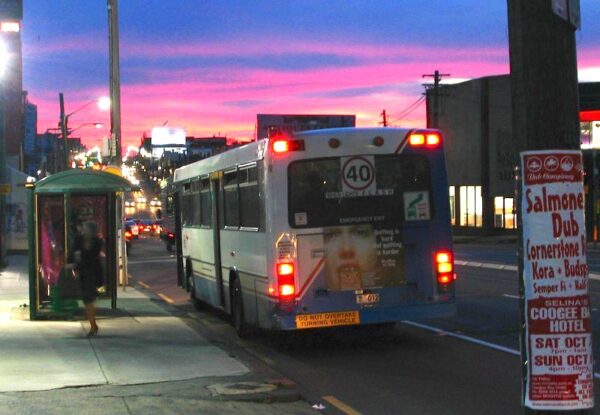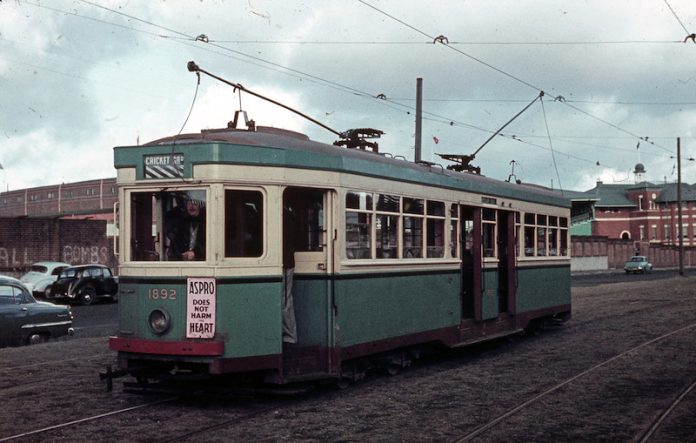On a warm November day in 1958, the jacarandas are in bloom and the systematic destruction of Sydney’s tram network is in full swing.
Students trickle out of the University of Sydney quadrangle and across the lawns, down towards Parramatta Road. From there, they board several different tram lines that ding their bells as they head down to Central, up Glebe Point Road, across to Lilyfield and Balmain, or up Parramatta Road towards the bustling Italian café bars and barber shops of Leichhardt, and onward to Haberfield.
A few months earlier, news had broken that the tram services to the university would end on November 23, in the middle of exam-period. The Student Representative Council (SRC) voiced its protest: bus services would probably take three weeks to be up to scratch, and would cause major disturbance to students. The City of Sydney Council begged the government to wait until after the Christmas shopping rush, but to no avail.
So, for the last few weeks of its existence, the line from the city shot up past the university and along Parramatta Road traversing the then vibrant shopping strip, passing by the Olympia De-Luxe Picture Theatre and the legendary Albert Palais dance hall on its way; the venue was once such a popular nightlife meeting place it was colloquially known as ‘the marriage bureau’.
The older trams were affectionately nicknamed ‘toast racks’ for their horizontal configuration, with two open cross-bench compartments at each end and four single-bench seats with doors in the middle of each carriage. They also earned the moniker of ‘rattlers’ for their mode of operation. There was also a less common, newer design with a single closed carriage with doors at the front, middle and back. All were painted in the same two-tone colour scheme: pastel yellow in the middle, green on top and bottom.
In 1945, the year of its peak patronage, Sydney’s tram network recorded 400 million trips, the uptake motivated in part by war-time petrol rationing. This extraordinary figure exceeded the number of passengers Sydney Trains carried in 2020, with the city’s population only half of what it is now.
But the post-war boom in personal cars from the 1950s would see trams face fierce competition for street space. In the end, pressure from increasingly affluent and influential car owners prevailed. The NRMA lobbied mercilessly on their behalf, and the government eventually judged it to be more cost effective to replace the ageing fleet and run-down tracks with diesel buses. Local communities protested against the removal of their lines, but the network’s destruction was completed in 1961 on February 25 when the last tram ran from the city to La Perouse.

On a hot November day six decades later, I am walking up Parramatta Road for a haircut. I pause momentarily at the bus stop, but decide against waiting for the next one. A lot of routes were recently cut, making services at times infrequent, with periods when several buses will suddenly appear in quick succession, a likely side effect of the countless sets of traffic lights that bottleneck traffic along the stretch. It’s only a 20-minute walk so I set off up the desolate, congested stretch to a soundtrack of traffic and the scent of exhaust fumes. The road, half its shopfronts vacant and abandoned, features a strange mix of specialist stores and studios: wedding dresses, mechanics, a trophy store, a beads shop, martial arts gyms, massage parlours, music shops and dance studios.
I pass by the Olympia Milk Bar, the last remaining evidence of the cinema that once stood next door where an uninspiring apartment block now squats. Despite the weathering of time, the façade of the milk bar is almost totally unchanged since the middle of last century. Its tattered technicolour signage, with several letters missing, still invites you in for ice cream, smokes, and sweets. Lost in time, the shop goes unnoticed. The tram too once made a stop here. The council shut down the milk bar years ago, but every day its octogenarian owner sits in the back wearing his apron. Further up the road the Albert Palais still stands; in COVID times it has again become one of a few go-to dance destinations in the city, as a budget venue for weddings that have intermittently been the only exception to the ‘no dancing’ rule. As I write, this social distancing measure is one of the few that remains in place.
I have long had trouble getting a good haircut. The Italian barber I have been going to lately always does a good job, and other than a well warranted look of disgust on my first visit, he has never complained. At seventy-one, he has been cutting hair on Parramatta Road for 55 years. He tells me he’ll give it up when his hands start shaking.
Standing back out on the noisy four-lane road, I watch the cars drive past. Most carry only a solitary driver, and few have more than one passenger. Boarding the bus, though wearing of masks is now mandatory, more than a handful of passengers conspicuously omit them. Last summer, the bushfire smoke made them a necessity. Perhaps living within our ecological limits means dreaming up an efficient, well-connected public transport network. Perhaps the future looks a lot like the past.


